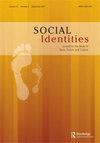未成年移民如何成为主导者:以20世纪越南中部高地的金人为例
IF 0.7
Q3 ETHNIC STUDIES
引用次数: 1
摘要
到二十世纪,中央高地已成为土著少数民族的传统居住地。1858年,法国殖民者在整个地区建立了工业作物种植园,这最终形成了京族人向中央高地的第一波移民。1957年,越南共和国政府通过土地开发计划创建了第二波京族移民到中部高地。1965年至1975年期间,越南战争的暴力升级促使第三波战争难民移民到中部高地。第四次浪潮(1976-1989)是越南社会主义共和国在全国范围内重新分配人力资源的努力的结果,其中大部分人口从平原转移到中央高地,以建立新的经济区。到20世纪90年代初,随着世界范围内的“咖啡热潮”和私营经济部门的法律认可,自由移民到中央高地种植咖啡树的浪潮爆发了——这是第五波浪潮。上述五次移民浪潮的连续发生,彻底改变了中部高地的人口和土地所有权结构,也给该地区的社会经济生活带来了巨大的变化。在调查这些变化的同时,我们的文章试图对京族在向高原迁移的五次浪潮中在中央高地获得统治地位的过程提供一个全面的解释。本文章由计算机程序翻译,如有差异,请以英文原文为准。
How minor immigrants became the dominants: the case of the Kinh people migrating to the Central Highlands, Vietnam in the twentieth century
ABSTRACT By century XX, the Central Highlands was being the traditional residence of indigenous ethnic minorities. In 1858, the French colonialists established plantations of industrial crops all over the area, which ended up forming the first wave of the Kinh people's migration to the Central Highlands. In 1957, the Republic of Vietnam government created the second wave of Kinh emigration to the Central Highlands through the Land Development Program. In the period 1965–1975, the violent escalation of the Vietnam War prompted the 3rd wave of war refugees migrating to the Central Highlands. The 4th wave (1976–1989) was the result of the efforts of the Socialist Republic of Vietnam to redistribute human resources throughout the country, in which a large part of the population from the plains was moved to the Central Highlands to build new economic zones. By early 1990s, with the worldwide ‘coffee boom’ and the legal recognition of private economic sector, the wave of free migration to the Central Highlands to plant coffee trees exploded - this was the 5th wave. The continuum of the above five waves of migration has completely changed the population and land ownership structure of the Central Highlands as well as brought great alterations to the socio-economic life of this region. While investigating such changes, our article seeks to provides a comprehensive explanation on the process in which the Kinh gained their dominance on the Central Highlands over the five waves of their migration to the plateau.
求助全文
通过发布文献求助,成功后即可免费获取论文全文。
去求助
来源期刊

Social Identities
ETHNIC STUDIES-
CiteScore
2.00
自引率
0.00%
发文量
22
期刊介绍:
Recent years have witnessed considerable worldwide changes concerning social identities such as race, nation and ethnicity, as well as the emergence of new forms of racism and nationalism as discriminatory exclusions. Social Identities aims to furnish an interdisciplinary and international focal point for theorizing issues at the interface of social identities. The journal is especially concerned to address these issues in the context of the transforming political economies and cultures of postmodern and postcolonial conditions. Social Identities is intended as a forum for contesting ideas and debates concerning the formations of, and transformations in, socially significant identities, their attendant forms of material exclusion and power.
 求助内容:
求助内容: 应助结果提醒方式:
应助结果提醒方式:


